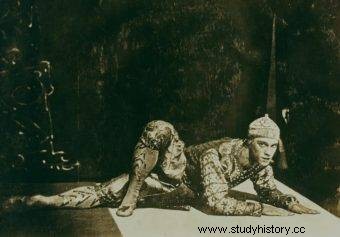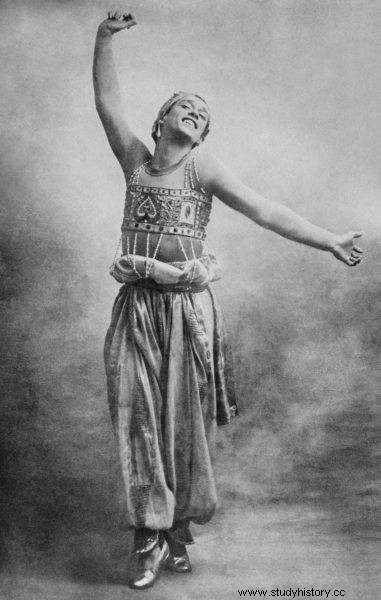An outstanding dancer, a scandalous choreographer, the muse of the famous Sergei Diaghilev, and besides, a bisexual and schizophrenic ... You can say a lot about Wacław Niżyński, but never that he was an average person. He fully deserved to be called the god of dance. And like many other gods, he was quickly knocked off its pedestal.
Dancing was in his blood. His parents - Tomasz Niżyński and Eleonora Bereda - were ballet dancers of Polish origin. He was also a Pole with his heart. Born in Kiev on March 12, 1889, baptized in Warsaw in the Church of the Holy Cross (where Chopin's heart rests today), years later, in letters to the singer Jerzy Reszke, he wrote:"My mother gave me milk and Polish language, and for this I am a Pole. . (...) I can't speak well because I was not allowed to speak Polish. ”
Born for the scene
Before Wacław and his siblings appeared in the world, Tomasz and Eleonora performed with a traveling dance group. As the family grew, however, they felt the need for stability. So they settled in St. Petersburg and tried to get a job in the Imperial Mariinsky Theater. Unsuccessfully. Even so, they were doing quite well (at least until their father had ripped up his belongings and abandoned his wife and children for another woman).

You can say a lot about Wacław Niżyński, but never that he was an average person. He fully deserved to be called the god of dance.
From an early age, Wacław showed an extraordinary flair for ballet. And it is hardly surprising, since - as he said himself:" My parents considered teaching me to dance as something as natural as learning to walk or speak . Even my mother, who of course remembers my first tooth, couldn't tell exactly when I had my first lesson. "
He was good at dancing. With all the rest - definitely worse. A withdrawn boy living in his world had difficulty making friends with his peers. Anyway, at school he was not interested in anything but more ballet figures. He consistently disregarded general-purpose subjects and delegated the solving of homework to his sister, Bronisława. It was supposed to hit him with a hiccup. Violetta Wiernicka in her latest book "Poles who amazed Russia" describes:
One-sided interests meant that Wacław was not a well-read man and he did not master any foreign language, even at a basic level, which made his life difficult during his performances abroad and abroad.
However, this did not prevent him from making a turbulent - though extremely short, because it lasted only six years - career.
Costume intrigue
In 1907, Niżyński graduated from the Imperial Theater School and made his debut on the stage of the Mariinsky Theater in the role of Mozart's Don Giovanni. It was impossible to ignore his talent - and hardly anyone did. He was appreciated by the most outstanding Russian dancers of that time:Tamara Karsawina, Anna Pawłowa and Matylda Krzesińska; other lovers of Wenceslas also appreciated - Prince Pavel Lvov and the legendary founder of the Russian Ballets Ensemble Sergey Diaghilev.
In 1911, in an atmosphere of scandal, he was dismissed from the Mariinsky Theater due to ... obscenely tight costume in the play "Giselle" (he was wearing a leotard, but did not put on the short shorts that dancers used to wear at the time, thanks to which his hips "appeared to the audience in their in all its glory "). From then on, he only danced at Diaghilev's.

The text was created, among others based on the book by Violetta Wiernicka "Poles who amazed Russia", which has just been published by the Bellona publishing house.
He climbed to the top in no time. As Violetta Wiernicka comments in the book "Poles who amazed Russia":"In Europe, apart from Russia, there were no male dancers with classical ballet preparation . Before the Russian Ballets arrived in Paris, dancing was considered a women's activity , the male roles were danced by women en travesti, that's why Nijinsky and other dancers from Diaghilev's group made a sensation there. ”
At the same time, he also tried to revolutionize ballet as a choreographer. He made his first choreography (for Debussy's Afternoon of a Faun) in 1912. However, the audience was not ready for it - they found the ballet chaotic and incomprehensible, and the erotic scenes - shocking. They reacted the same way to his arrangement of Stravinsky's The Rite of Spring.
And although Jean Cocteau could not praise Nijinsky, he wrote:"He overthrew all the laws of equilibrium, turned them upside down, resembles a human figure drawn on the ceiling, he feels light in the air", his star began to dim a bit ...
Read also:Empress Sisi, Matylda Krzesińska, Jenny Lind. The most beautiful women of the 19th century
"And now I will dance the war"
In 1913, his promising career was brutally cut short. Once again he flew out of the ballet company, this time for ... marriage. During the stay of the Russian Ballets in Buenos Aires, Nijinsky married a more unknown dancer Romola de Pulszky. Violetta Wiernicka describes:
An enraged Diaghilev informed the Pole that "his services are not needed." The news of the wedding also unpleasantly surprised the dancer's mother, who dreamed that her beloved son would marry Polish woman - opera singer Maria Piltz, soloist of the Imperial Mariinsky Theater. Eleanor had a hard time accepting the thought that "Wacław and Marusia" would never be together.

Wacław Niżyński was one of the greatest dancers of the 20th century.
The marriage turned out to be so successful that she had a daughter, Kira (like her grandparents and parents, she later became a dancer). However, it was the beginning of the end for Wacław.
In the following years, a series of misfortunes fell on him:his attempt to organize his own ballet troupe ended in a spectacular failure, and after the outbreak of World War I, he was interned as a Russian citizen in Austria-Hungary (where he was forced to live with his wife and child after "parting" with Diaghilev) . To make matters worse, when two years later the ex-lover gave him a second chance and allowed him to perform in Strauss's ballet "Till Eulenspiegel", the audience received the choreography disastrously.
In 1918, Nijinsky took the stage for the last time. He was supposed to dance at the charity evening for the Red Cross, but during the dance he suddenly stopped, placed a cross made of black and red fabric on the floor and announced to the audience:"And now I will dance a war you didn't stop… ”.
Soon after, he was diagnosed with schizophrenia. In a way, he could have expected it - with the Nijinskis it was family. "His grandmother, who died after giving up food completely, and his older brother Stanisław suffered from schizophrenia," comments Violetta Wiernicka in the book "Poles who amazed Russia".
The dethroned god of dance, "Eighth Wonder of the World", "Man-Bird" and the former sex symbol spent the last three decades of his life wandering around various psychiatric institutions. As his relatives recalled, Wacław was completely indifferent to their presence and "resembled an amoeba". In the 1930s, he was subjected to an innovative insulin therapy, which had a positive, but short-lasting effect. He died of nephritis in London on April 8, 1950. He was buried in Paris at Montmartre Cemetery (in 1953)
